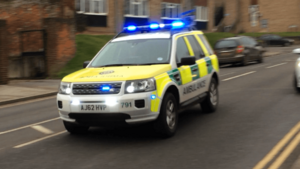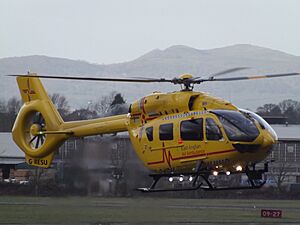East of England Ambulance Service facts for kids
Quick facts for kids East of England Ambulance Service NHS Trust |
|
|---|---|
 |
|
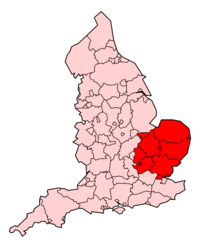
Area served by East of England Ambulance Service NHS Trust
|
|
| Type | NHS trust |
| Established | 1 July 2006 |
| Headquarters | Royston, Hertfordshire |
| Region served | Norfolk, Bedfordshire, Cambridgeshire, Essex, Hertfordshire and Suffolk |
| NHS region | NHS England |
| Area size | 7,500 square miles (19,000 km2) |
| Population | 6.2 million |
| Budget | Approx. £247 million |
| Chair | Mrunal Sisodia |
| Chief executive | Neill Moloney |
| Staff | 4,780 (2019) |
The East of England Ambulance Service NHS Trust (EEAST) is a special team that provides ambulance services. They help people in six counties in the East of England: Bedfordshire, Cambridgeshire, Essex, Hertfordshire, Norfolk, and Suffolk. This area is home to about 6.2 million people.
EEAST is one of ten ambulance services in England. It is part of the National Health Service (NHS). The government provides money for its important work.
Besides emergency ambulances, EEAST also helps with other services. They offer non-emergency patient transport. They also handle special operations like planning for big emergencies. This includes responding to incidents with dangerous materials. The service also works with charities like air ambulances. These charities provide doctors for very serious accidents.
EEAST helps coordinate critical care charities in its area. These include Magpas Air Ambulance, Essex & Herts Air Ambulance, and East Anglian Air Ambulance. Other groups like BASICS Essex Accident Rescue Service also help. These teams are sent out by a special paramedic and dispatcher. They check every emergency call to decide if a critical care team is needed.
Contents
History of EEAST
The East of England Ambulance Service NHS Trust started in 2006. It was formed when three smaller ambulance services joined together. These were the Bedfordshire and Hertfordshire Ambulance Service, the East Anglian Ambulance Trust, and the Essex Ambulance Service.
This merger created a service that covers a huge area. It helps 6.2 million people. Each year, it answers around one million emergency calls.
The East Anglian Ambulance NHS Trust was formed in 1993. It combined the ambulance services of Cambridgeshire, Norfolk, and Suffolk. The Bedfordshire and Hertfordshire service merged in 1992.
In 2009, the Care Quality Commission (CQC) checked the service. They found that some vehicles were not clean enough. EEAST quickly started a review to improve cleaning. They said keeping everything clean was a big challenge. This was because they had many stations across six counties.
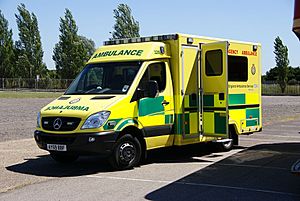
How EEAST Helps People
EEAST has many resources to help people. They employ over 4,000 staff members. They also have about 1,500 volunteers who give their time.
As of July 2016, EEAST had many vehicles and locations:
- 357 front-line emergency ambulances
- 201 rapid-response vehicles (RRV)
- 164 non-emergency ambulances for patient transport
- 52 special vehicles for major incidents
- Over 130 ambulance stations and response posts
- 3 control rooms in Bedford, Chelmsford, and Norwich
- 4 training centres for staff
The trust even has its own driving school. This school teaches drivers how to drive safely in emergencies. They learn to use blue lights and sirens.
Ambulance Stations
EEAST has 90 stations across the six counties. These stations hold different types of vehicles. They have emergency ambulances, rapid response vehicles, and patient transport vehicles.
Stations also have places for staff to rest. Staff can prepare ambulances and restock medical supplies there. Some larger stations are called "make ready" stations. At these, special teams clean, fuel, and maintain the ambulances. These larger stations can also house teams for major incidents.
EEAST also uses "response posts." These are smaller spots with restrooms and kitchens. They help control centres place crews in different towns. This helps ambulances get to emergencies faster. Some posts are small rented units. Others are reserved spots in places like fire stations.
EEAST Vehicles
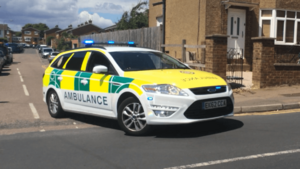
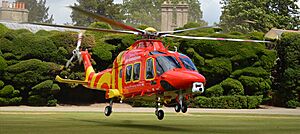
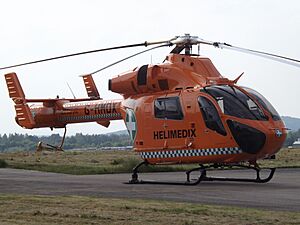
Emergency Ambulances
For many years, EEAST mainly used Mercedes-Benz Sprinter ambulances. They finished switching to a new Sprinter fleet in 2016. In 2018, they tried out four new types of vehicles. One was designed just for EEAST.
In 2019, EEAST started using new, lighter Fiat Ducato ambulances. These are slowly replacing the older Mercedes Sprinter models. Some staff members needed special training to drive the new Fiat vehicles.
By 2024, EEAST began replacing its fleet again. They added Renault Master ambulances. They also got M.A.N TGE ambulances for special uses. These are currently used as regular ambulances. EEAST is also bringing in Ford Transit and M.A.N ambulances. These will replace the Fiat Ducato models.
For rapid response cars, EEAST often uses Skoda Octavia Scout vehicles. In 2024, they added Skoda Kodiaq and electric Skoda Enyaq cars. Volkswagen Transporter vans are also used for managers and urgent care.
Patient Transport Services
EEAST also provides patient transport services. This service helps patients get to and from hospitals. It helps people going to appointments or leaving the hospital.
In 2015, a new fleet of Citroen Relay, Fiat Ducato, and Peugeot Boxer vans arrived. Some older Renault vehicles are still used for larger patients. These new vehicles can carry several patients. They can also secure wheelchairs or stretchers. Some of these vehicles have blue lights and sirens. They can be used in major incidents.
Air Ambulances
EEAST provides critical care paramedics to three local air ambulance charities. These are Magpas, Essex & Herts Air Ambulance, and the East Anglian Air Ambulance. These paramedics work with doctors. They give advanced medical care at accident scenes. EEAST uses these air ambulances, but it does not pay for the charities.
Tactical Operations Centre
The Tactical Operations Centre (TOC) watches over all calls and resources. They monitor how busy the service is. They also check how long vehicles are out of service. This team makes sure hospitals handle patients quickly.
The TOC also has a Critical Care Desk (CCD). This desk sends out the air ambulance teams. There is also an Incident Command Desk supervisor. This person sends out special teams for major incidents.
Staff in this department have important roles:
- Tactical cell assistant (TA)
- Critical care desk dispatcher (CCD)
- Incident command desk supervisor (ICD)
- People and vehicle support hub manager (PVSH/PVSH-M)
- Duty tactical commander (DTC)
Patient Transport Service Updates
In February 2018, EEAST took over patient transport services in Hertfordshire and Bedfordshire. This happened after the previous private company stopped operating. EEAST was given a two-year contract to provide this service.
Service Performance
The Care Quality Commission (CQC) checks how well ambulance services are doing. They give ratings to show how well a service performs. These ratings help everyone understand if the service is meeting expectations.
The CQC looks at different areas of the service. They check if services are safe, effective, caring, responsive, and well-led. The ratings can be Outstanding, Good, Requires Improvement, or Inadequate.
Here are the CQC ratings for EEAST over several years:
| Area | 2016 Rating | 2018 Rating | 2019 Rating | 2020 Rating |
|---|---|---|---|---|
| Are services Safe? | Requires improvement | Requires improvement | Requires improvement | Requires improvement |
| Are services Effective? | Requires improvement | Requires improvement | Requires improvement | Requires improvement |
| Are services Caring | Outstanding | Outstanding | Outstanding | Outstanding |
| Are services Responsive | Requires improvement | Requires improvement | Good | Good |
| Are services Well-led | Requires improvement | Requires improvement | Inadequate | Inadequate |
| Overall rating | Requires improvement | Requires improvement | Requires improvement | Requires improvement |
EEAST has been working to improve its services. They have hired many new staff members. They also invested in new ambulances. The trust aims to meet all emergency response time targets. They are always looking for ways to get to patients faster.
Working with Other Providers
In 2019, the CQC noted that ambulance services sometimes use private companies. This happens when they need extra help. EEAST spent money on private ambulances for emergency and non-urgent work. This helped them handle more calls.
Also in 2019, EEAST changed how it supports staff health. They hired a new company, Kays Medical, to provide occupational health services.
See also
- Emergency medical services in the United Kingdom
- Healthcare in Bedfordshire
- Healthcare in Cambridgeshire
- Healthcare in Essex
- Healthcare in Hertfordshire
- Healthcare in Norfolk


